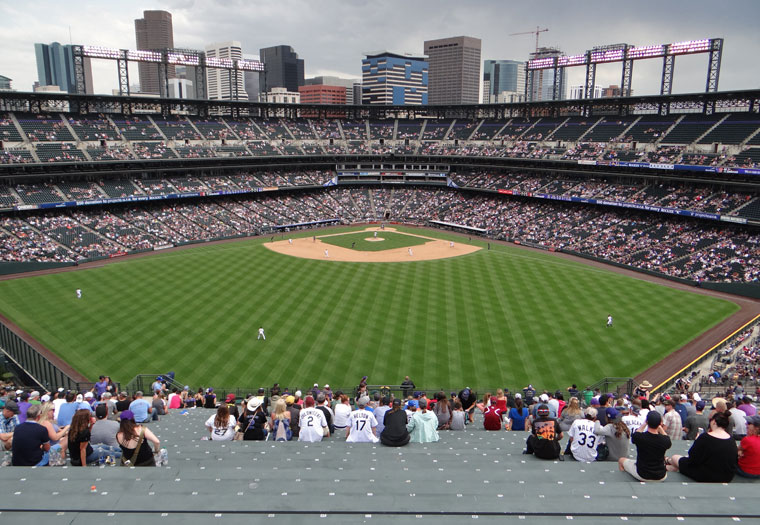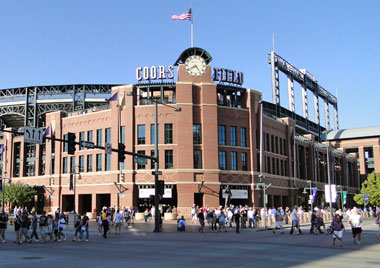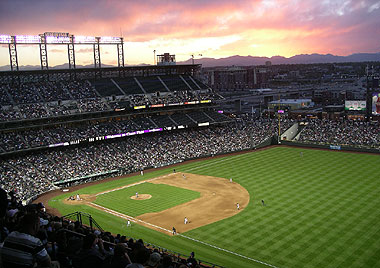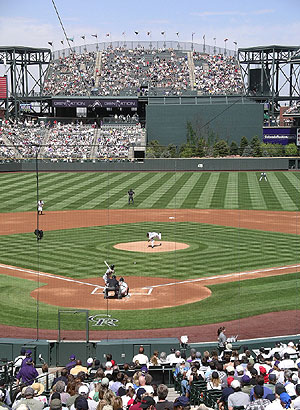
|
Coors Field was built in a spectacular setting, on the cusp of downtown Denver with the Rocky Mountains in the distance. But despite its surroundings, Coors doesn’t have the majestic views you’d expect from its splendid location.
As a result, Rockies fans have a wide selection of nearby diversions that compare favorably to any big league city, even rivaling the more cluttered neighborhoods that add to the experience of seeing a game at Wrigley or Fenway. But the ballpark experience itself is surprisingly underwhelming as a result of its orientation. Although Coors Field is a downtown retro ballpark, built of brick and steel, it doesn’t capitalize on its impressive surroundings: the Denver skyline and mountain range that gave the team its name. Although the city of Denver feels more quaint than large, it still has an impressive array of skyscrapers, with the Qwest building tallest among them. But fans at Coors Field can only view the skyline if they are sitting in the outfield bleachers, meaning the vast majority of patrons have no glimpse of downtown from the ballpark’s three tiered grandstand. Unfortunately, if the ballpark had been built to face downtown the sun would set in the line of vision of hitters. So to prevent batters from squinting in the sun, Coors Field faces away from downtown. So what is the backdrop for the fans in the upper deck? Mainly non-descript buildings and highways and byways fill a rather unassuming portrait. If you’re expecting to see the Rocky Mountains be forewarned that only seats in the upper deck extending from first base to right field have views of the mountains that loom on the horizon. The mountains are further away than you think, and their visibility depends on the weather. On a hazy Sunday afternoon the Rocky Mountains are obscured, but on a clear evening the mountains at sunset look to be those that inspired the “purple mountain majesties” lyrics in America the Beautiful, as their dark outline stands out thanks to the stark contrast of the colorful sky. Fans fortunate enough to be sitting in certain sections of the upper deck at the right time of evening are treated to a scene worthy of a postcard, but otherwise the ballpark is pretty typical of the modern era. The now obligatory ribbon scoreboards ring the façade of the second deck. The team’s exclusive restaurant/bar is called The Mountain Ranch Club, and its visible location is in the corner of right field on the second level.
The bullpens in right-center field are elevated and fans hover just above pitchers warming up from the 360-degree concourse. There are lots of great vantage points of the game from the wrap around concourse (one of the best in the Majors), which was designed so that fans never lose sight of the field. For those not wanting to stand, lower level ushers are friendly but not very inquisitive if you want to upgrade your seats, although they only let you walk down the aisle between batters and innings, not pitches. The most unique feature of Coors Field is derived from the city’s elevation. All of the seats are painted green with the exception of the upper deck's 20th row, which is painted purple to mark the exact spot where the ballpark is one mile above sea level. Coors Field was originally designed to seat 43,800 fans, but while it was being constructed the Rockies were breaking attendance records at their temporary home, Mile High Stadium. After averaging 57,051 fans per game in two seasons at Mile High, Rockies ownership decided to increase capacity at Coors to 50,200 in time for its inaugural Opening Day. The Rockpile was one of the sections that was added and, literally built by popular demand, it has become the ballpark’s signature seating area. Elevated above the batter’s backdrop, the Rockpile is a semi-circular shaped 2,300-seat bleacher section located in straightaway center field. Although fans sitting in the Rockpile bear the brunt of any cold and windy weather, they are treated to the best views of Denver’s skyline, and despite the distance from the field these tickets sell well, thanks in part to their inexpensive price ($4). Tickets in general are easy to come by these days in Colorado. After the Rockies lead the National League in attendance during Coors Field’s first five seasons, the team’s average has dipped from 48,037 in 1996 to just 23,634 in 2005. With such a pronounced slip in demand, the team decided in 2006 to close large portions of the upper deck for a majority of games. The sections closed are the upper portions of seating in right field and down the third base line. After a decade of use, Coors Field has undergone very little change since its first game on April 26, 1995. The main scoreboard in left-center field was recently upgraded to a full-color LED display, but the only noticeable change is the mountain scene the team created to add life to the usually drab batter’s eye area. Featuring numerous evergreen trees and a pond with seven small fountains and three waterfalls, the Rockies’ nature scene appeared in 1997 and is now one of the focal points of the ballpark.
On its exterior, Coors Field exudes charm. The main home plate entrance at the intersection of 20th and Blake Streets was built with hand-laid brick. An old-fashioned clock rests between the words “Coors” and “Field.” A bronze statue, called The Player, stands as a tribute to Branch Rickey. It was commissioned by the Denver Rotary Club, who awards the annual Branch Rickey Award to one Major League player for exceptional community service. The statue contains the names of all winners since the award was established in 1992. On games days the area outside of the ballpark is a hub of activity. The Rockies seem to do pretty well on day of game ticket sales, so the lines at the ticket windows get backed up near game time. Despite a strong police presence, scalpers line the side of Blake Street opposite the ballpark, and buying tickets on the street will save you a lot of time in line. Parking is plentiful near the ballpark, but most of it is in the $10-$20 range. The exception is the Ampco System Parking lot, located at 20th and Arapahoe. Located just a handful of blocks from Coors Field, Ampco charges only 50 cents for parking on weekends and after 4 pm during the week, making parking cheap there for the majority of Rockies games. There are plenty of spaces in the Ampco lot, which is not much more than a 5-minute walk away. Although Coors Field doesn’t provide the sweeping views of skyline and mountains you’d expect, it is a friendly and comfortable place to watch a ballgame and worthy of praise for being the centerpiece of a rejuvenation effort in Denver.

Coors Field Footnotes - Facts & Figures
| |||||||||||||||||||||||||||||||||||||||||||||



 The 14-foot high wall in right field serves two purposes. The hand-operated out-of-town scoreboard makes up the top portion, and just like in other retro parks if the ball hits off the scoreboard it’s in play. The wall’s lower portion is covered with glass and serves as a private seating area with field level views reserved for corporations and parties.
The 14-foot high wall in right field serves two purposes. The hand-operated out-of-town scoreboard makes up the top portion, and just like in other retro parks if the ball hits off the scoreboard it’s in play. The wall’s lower portion is covered with glass and serves as a private seating area with field level views reserved for corporations and parties.
